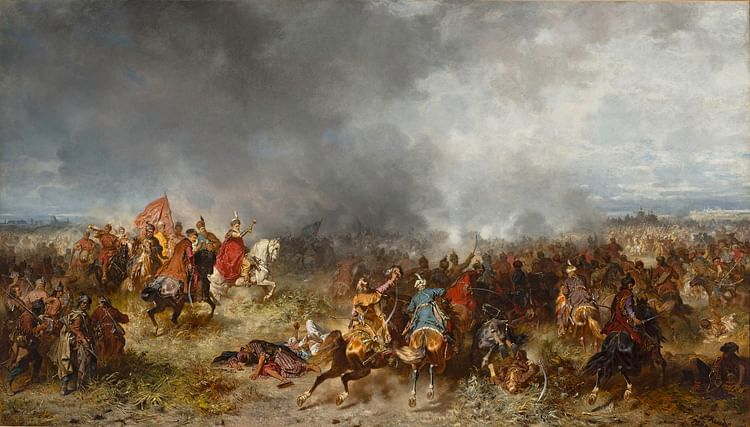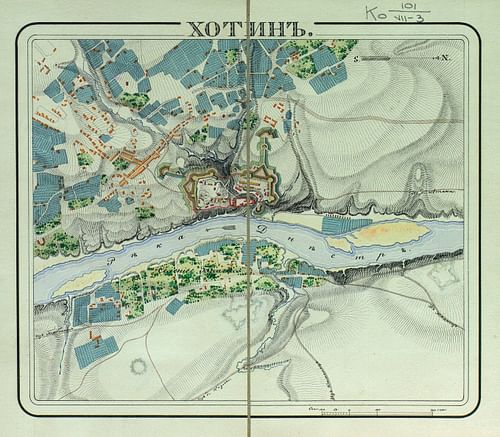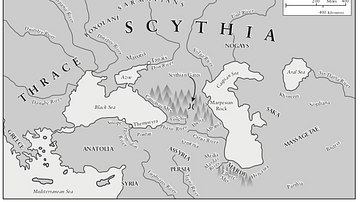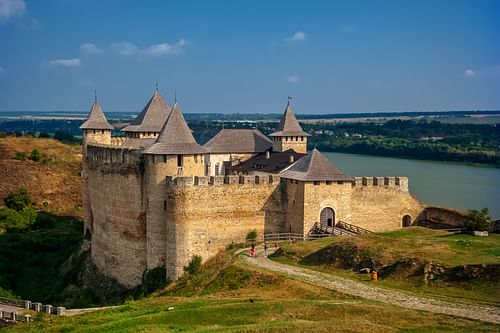
Khotyn fortress is a complex of fortifications situated on the hilly right bank of the Dniester in Khotyn, Ukraine. It consists of a 13th-century stronghold and an 18th-century bastion surrounding it. It is one of the oldest preserved fortifications of Eastern Europe.
The Medieval Fortress
There is no information in written sources about the construction date of the first fortifications at this place, but archaeological excavations in the 1960s discovered the remains of an early fortified structure. The first castle had wooden walls and earth ramparts, and it was possibly constructed in the early 11th century by the Grand Prince of Kyiv Vladimir the Great (l. c. 958-1015), who conquered the area around that time and wanted to control the river crossing and gain access to a major trade route.
In 1199, the city and the fortress became part of the Galicia-Volhynia Principality, which used the fortress on the banks of the Dniester, then the border of the principality, to defend the frontier. In the middle of the 13th century, Daniel I of Galicia (l. 1201-1264), King of Ruthenia (formerly Galicia-Volhynia), reinforced the stronghold by replacing the wooden fortifications with stone ones.
With the economic crisis of the 14th century in Europe, Genoa sought new income sources. Such an income stream was the Black Sea Basin, which includes the Dniester, as these lands were abundant in agricultural resources. Thus, by the first half of the 14th century, the Genoese created a trade network all across the Danube, the Dniester, the Sea of Azov, and Crimea. Considering the weakness of the Kingdom of Ruthenia in the early 14th century, the Genoese were able to take over the Dniester trade route, and the Khotyn stronghold became a remote outpost defending the trade network.
With the foundation of the Principality of Moldavia in the mid-14th century, under the rule of Dragoș the Founder (d. 1353), the vassal of the Kingdom of Hungary, all the fortifications and trade posts on the Dniester, including Khotyn, came under the rule of Moldavia. In the 15th century, the stronghold was significantly rebuilt and became the residence of the local governor.

In the second half of the 15th century, the Ottoman Empire wanted to conquer Southern Bessarabia and was afraid of the strategic location of the Principality of Moldavia. In 1473, Moldavia refused to pay its annual tribute to the Ottoman Empire, and so Mehmed II the Conqueror (r. 1451-1481) invaded Moldavia in 1474. In 1476, his army reached Khotyn, but the fortress proved impregnable, and the siege was unsuccessful.
The Ottoman Period
At the beginning of the 16th century, the Principality of Moldavia became a vassal of the Ottoman Empire, and the janissary garrison of the region took over the fortress. In the 1530s, Petru Rareș (l. c. 1483-1546), the Prince of Moldavia, attempted to conquer the Pokuttya, a region northwest of Khotyn, starting a war with the Kingdom of Poland. However, the Polish army was much stronger, and in 1538, it laid siege to Khotyn and captured the stronghold. During the siege a large section of the wall between the north and east towers was blown up, part of the palace near the east wall, the gate, and the blacksmith's tower were destroyed. The castle was rebuilt and expanded from 1540 to 1544: the walls and the blacksmith's tower were restored, and the new gate was built. The Poles controlled the fortress until 1617 when the Peace of Busza was signed and the fortress came under the rule of Ottoman Moldavia.
In 1620, the tension between the Polish-Lithuanian Commonwealth and the Ottoman Empire reached its peak. The Tatars and the Cossacks, subjects of the Turkish Sultan and the Polish King, respectively, had been in constant conflict, with the Tatars raiding southern lands of the Commonwealth to capture slaves and the Cossacks plundering Ottoman towns and trade points, even threatening Istanbul. Poland had also interfered in the internal affairs of Moldavia, and so, in 1621, Sultan Osman II (r. 1618-1622) gathered an army of almost 160,000 soldiers and launched an invasion. The army of the Polish-Lithuanian Commonwealth and their Cossack allies numbered around 50,000 to 60,000 troops. The armies met under the walls of Khotyn, and the battle ended with a Polish-Lithuanian victory. The Peace Treaty of Khotyn recognized the Commonwealth-Ottoman border on the Dniester, but the fortress remained under Ottoman rule.
In 1673, the army of Poland-Lithuania, under John III Sobieski (l. 1629-1696), faced the Ottoman military again. The Commonwealth was victorious; they even managed to capture the fortress, albeit briefly. Afterwards, the Ottomans decided to demolish the castle, but the local governor did not complete the task, and so the castle survived.
At the beginning of the 18th century, the Ottoman Empire was seriously concerned about the growing power of the Tsardom of Russia. They were afraid that the Russians would attack the Polish-Lithuanian Commonwealth and then Ottoman Moldavia, where a large part of the population was Orthodox Christian. Moreover, the Turks wanted to reconquer the lands that were lost to Russia after the Treaty of Constantinople in 1700. In 1710, the Ottoman Empire declared war on the Tsardom of Russia, and a year later, Peter the Great (l. 1672-1725) started the Pruth River Campaign, invading Moldavia. The campaign was unsuccessful for Russians, and they had to sign a new peace treaty with the Ottoman Empire.
The Ottomans reinforced all the fortifications on the Dniester, which performed a role of the northern border. The Khotyn stronghold was significantly rebuilt, and a new bastion fortress was constructed around it. The newly built fortification had seven bastions and five fortified gates. The outer side of the shaft was fortified with a stone wall, in front of which was a moat. The old stronghold was connected to the whole fortification system by a wall. The new 30-hectare (74-acre) complex could house a garrison of 20,000 with provisions and ammunition in peacetime and up to 60,000 troops during hostilities. The stronghold performed the function of an arsenal.
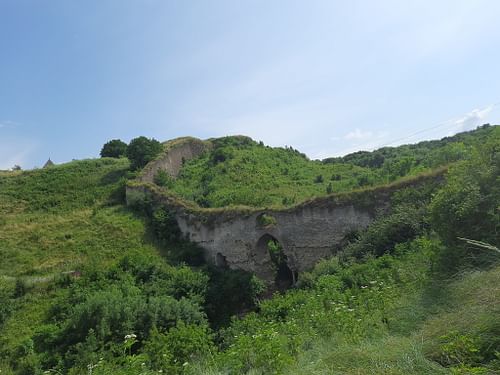
Later History
In the 18th century, the fortress frequently changed hands. During the Russo-Turkish War of 1735-1739, the Russian troops defeated the Ottoman army at Stavuchany (1739), near Khotyn, after which the Ottoman garrison of the fortress surrendered without a fight. With the Peace Treaty of Belgrade later that same year, the Ottoman garrison returned. In 1769, during the Russo-Turkish War of 1768-1774, the Russian army faced the Ottomans on the Dniester. The battle ended with the defeat of the Ottomans and the withdrawal of the Khotyn garrison. However, the Treaty of Küçük Kaynarca (1774) did not change the Dniester border, and so the fortress came under Ottoman rule again.
In 1787, the Ottoman Empire made an attempt to reconquest the lands lost to Russia in the previous wars. The Austrian Empire joined the war on the Russian side, and the Russian-Austrian army surrounded and besieged the fortress of Khotyn. The fortress surrendered, but, again, the Treaty of Jassy did not change the Dniester border, and the Ottoman garrison regained control of the fortress.
In 1806, Russian troops crossed the Dniester into Moldavia, starting the Russo-Turkish War of 1806-1812. Without resistance, the Khotyn commander handed over the fortress to the Russians. Finally, in 1812, under the Bucharest Peace Treaty, Khotyn officially became part of the Russian Empire. Thereafter, the fortress lost its strategic importance; it became the headquarters and infirmary of the Modlin Infantry Regiment, stationed in Khotyn. Nowadays, the complex is a historical reserve; the fortress was restored to its 18-century state, and it is a popular tourist destination.
Castle Defence Structures
The castle, after dozens of reconstructions and refinements, has formed a fairly powerful defence system. In order to protect the castle from the artillery fire, as it is situated in the centre of a basin, the walls rise almost 40 metres (130 ft) above the ground. The north and west walls are surrounded by a small stream, and along the south wall is a moat.
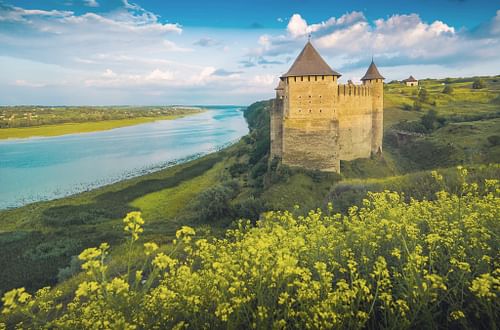
The walls are fortified with five towers, which allowed the castle to cover the surrounding hills with artillery fire:
- South Entrance Tower – Built in the early 18th century, the height of the tower is 20 meters, and the walls are 3-4 metres (10-13 ft) thick. Initially, the entrance to the stronghold was situated at the bottom of the tower, but in the 19th century, it was rebuilt, wooden bridges were added, and the entrance was moved up to the current level.
- Blacksmith's (South-west) Tower – The current tower, which was built in the 18th century, is a rebuild of a 15th-century one. Almost 29 metres (95 ft) high, with walls 2 metres (6.5 ft) thick, it housed the castle's forge.
- Commandant's (West) Tower – Constructed in the 15th century, the tower was directly connected to the commandant's palace. The height of the tower is 62.5 metres (205 ft), and the walls are 2 metres (6.5 ft) thick. On the upper story of the tower, there were loopholes for artillery fire.
- East Tower – The tower was built in mid 15th century. The height of the tower is 55 metres (180 ft). Inside, the tower is a 6-metre-thick (20 ft) solid part of the wall, therefore the only way to get to the loophole level is through the castle walls.
- North Tower – Constructed in the mid 15th century, the tower was the keep of the castle. It has four tiers with loopholes that were used for artillery and musket fire. The walls of the tower are 68 metres (223 ft) high and 2 metres (6.5 ft) thick.
Castle Courtyard
The courtyard is divided into two halves by the house of the commandant. The northern part, which is the oldest part of the castle, is referred to as Duke's Yard or Commandant's Yard, while the southern part of the stronghold is called the Yard of Warriors.
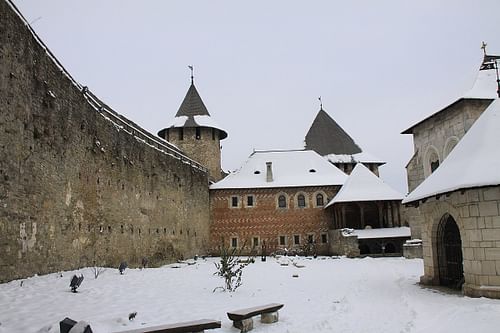
The majority of the buildings are located in the southern part:
- The house of the commandant – The 15th-century two-story palace was built of white stone blocks and red bricks. Inside, the palace is divided into residential and keeping parts. The palace also had portals and white stone frames, but the majority of these elements were lost in the 19th and 20th centuries.
- Barracks – The two-story living quarters of the stronghold garrison were constructed in the 15th-century along the eastern wall. Rebuilt many times throughout history, they currently house a museum of the fortress.
- Castle well – Located in the middle of the courtyard, it is 50 metres (164 ft) deep and dates back to the 15th century.
- Castle chapel – The date of the construction is unknown, but it was probably built between the 13th and 15th centuries in the Romanesque and Gothic architectural styles. It was rebuilt many times, converted into a mosque in the Ottoman period and reconstructed into an Orthodox church in the early 19th century.

